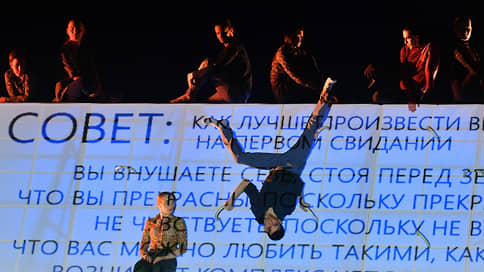Review of the premiere of the performance of the Chelyabinsk Theater of Contemporary Dance “Dialogues”
[ad_1]

At the New Opera, as part of the Epiphany Festival, the Moscow premiere of the performance of the Chelyabinsk Theater of Contemporary Dance “Dialogues” took place, staged by its director Olga Pona “in collaboration with the dancers.” I didn’t find a common language with the production Tatiana Kuznetsova.
The Chelyabinsk troupe is one of the oldest in Russia; in 2022 it celebrated its 30th anniversary. And all this time she remained among the leaders of Russian modern dance, without betraying the principles found at the very beginning of her journey. The founder and director of the troupe, Olga Pona, is first and foremost a teacher, and only then a dancer and choreographer. Back in the early 1990s, at European master classes, she learned the basics of contemporary dance and managed to train dancers; 30 years ago, its artists stood out from their competitors in their athleticism and endurance. At the same time, Olga Pona staged on generally understandable themes, usually from the youth life of the Russian hinterland, often supplementing the performances with video footage of Russian nature and sports structures from machines and walls with loops and belts, allowing bodily exercises not only on the floor, but also on vertical surfaces. Her boys and girls quarreled, made peace, thirsted for love and looked for their place in life through “somersaults, flips, bridges, racks, grabs, splits, batmans and other physical education achievements,” as Kommersant wrote 20 years ago.
The new “Dialogues”, with sound design and design by the director herself, were staged in the summer of 2023, but fit the old description quite well. Although new shades are also being discovered. Firstly, Olga Pona now teaches not only how to move, but also how to choreograph: the program indicates that among the two dozen dancers of the Chelyabinsk troupe there are as many as 13 choreographers. Secondly, “Dialogues” is distinguished by a certain thoughtfulness: the tempo is slower than usual, the movements are not marked by energy, the composition is not dynamic. Thirdly, the ten actors involved in the performance (they are also, as follows from the program, Pona’s co-authors) write like identical twins: all the fragments of the “Dialogues”, constructed according to the number principle, are so similar in movements, techniques and temperament that they seem like one 65 – a one-minute monologue, which is pronounced alone, and in a duet, and in a quartet, and in choir.
The monotony of the statement at first glance seems inexplicable, because the luminous lines crawling along the inclined panel installed at the back and preceding the next episode belong to a variety of authors – from Plato to Zhvanetsky – and, therefore, invite a variety of ways of self-expression – from the absurdist to the philosophical . The obvious explanation for the stylistic, genre and lexical limitations of “Dialogues” is that choreographer Pona’s co-directors compose the way they were taught by Pona the teacher. Analysis of texts is clearly not included in her program, so the choreographers are all the same – whether it’s Bakhtin or Kharms. They speak about the impossibility of mutual understanding in general and the longing for shared love in particular.
This intention can be understood by the lack of eye contact between the partners. Without looking, they roll over each other, drag women lying on the floor by the leg, thread the leg into the ring of other people’s hands, followed by intertwining of bodies and other confusion of limbs according to the letter of Moses’ unforgettable “Polka Labyrinth”. When a boy and a girl have to meet face to face, they keep each other at a distance, resting their outstretched hand on their counterpart’s forehead and trying to support each other with emphasis on the other’s head. The first heterosexual duet built on this principle even aroused respect for the rigor of the task and the literalness of its implementation. However, repeated many times in different gender combinations, this technique became pretty boring.
Illustrations of internal personality disorder were also not very diverse. Here, as a rule, the “isolation” technique was used – that section of it that involves moving a seemingly dead limb with the help of the three remaining ones. “Release” is also well mastered – freeing a muscle group for the best use of the rest. Asymmetrical “eights” of the body, wringing of hands behind the back, circular movements of bodies on the floor with support on the neck and other large-caliber ways of expressing spiritual unsettlement were complemented by expressive poses on the rear panel equipped with staples – the same one on which quotes from the classics were launched. And although such a “dance on the vertical” has been used in Western practice for about forty years, and in domestic practice since the Frenchman Regis Aubadie staged “The Rite of Spring” in the ballet “Moscow” in 2003, this “sturgeon of the second freshness” is partly masked the lack of more relevant findings. The most fascinating thing about the dance “Dialogues” was their literary accompaniment: quotes creeping across the panel easily distracted attention from the sluggish stage action. It was not always possible to guess their source: Plato remained elusive, Zhvanetsky was recognized immediately. And the most win-win quote turned out to be equally suitable both for “Dialogues” and for this review: “The author reserves the right not to meet your expectations.”
[ad_2]
Source link






